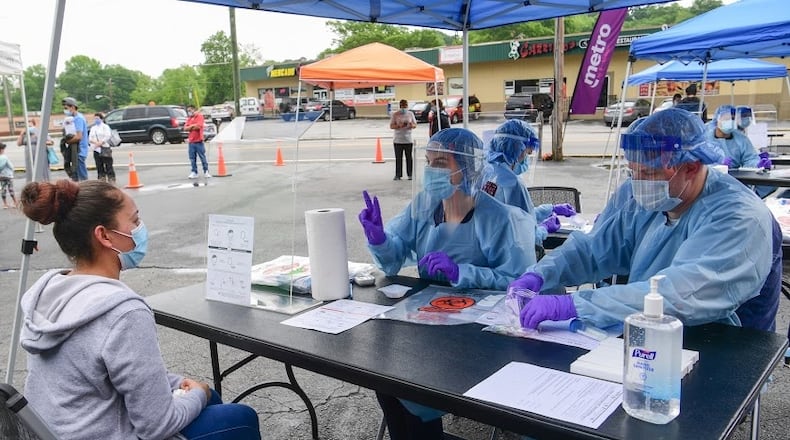Georgia reported more than 100 newly confirmed COVID-19 deaths on Wednesday for the second straight day, a death toll that has accelerated following the persistent surge in new coronavirus cases seen since May.
On Tuesday, the Georgia Department of Public Health (DPH) reported a record of 122 net new confirmed deaths, followed by the second-highest daily total Wednesday of 105. To date, 4,456 deaths in Georgia have been attributed to COVID-19.
Georgia also has set weekly records for reported deaths in each of the past three weeks topping out at 361 for the seven days that ended Saturday. Medical and infectious disease experts told The Atlanta Journal-Constitution the rising wave of deaths is likely to continue.
“We learned this lesson early on, and it seems like some of our leaders have to keep learning this lesson, that there’s always a delay between cases, hospitalizations and deaths,” said Ben Lopman, professor of epidemiology and environmental health, at the Emory University Rollins School of Public Health. “One follows the other.”
Georgia reported week-over-week case increases in nine out of 10 weeks from early May through mid-July, peaking at 25,471 cases the week of July 12. In the three full weeks since, Georgia has reported a slight decline in weekly cases, but the seven-day rolling average remains more than five times the level reported at the beginning of June.
Deaths are a lagging indicator of the virus’ progression. Reported deaths bottomed out the week of June 28 but have climbed each week since.
The state of Georgia now leads the nation in the rate of new daily cases per capita of the coronavirus, ahead of Florida, Alabama, Mississippi, California and Idaho, according to data published Wednesday by the Washington Post. Georgia also ranks tied for fourth in the per capita rate of newly reported deaths, the Post reported.
“Because we continue to have high levels of case counts in Georgia, it is expected we’ll see these severe outcomes of hospitalizations and deaths continue,” Lopman said.
Deaths reported on a given day typically do not occur on that day. They often occur days or potentially weeks earlier.
But the acceleration in new death reports is now appearing in the state’s date of death charts.
During the initial surge of the virus, the seven-day rolling average of deaths in Georgia peaked on April 20 at 44. During this latest surge in deaths, the rolling average of deaths has eclipsed the earlier high on July 27. As of Thursday, the rolling average for July 27 is 46.
But it is likely Georgia has not yet reached its peak in this most recent wave in deaths. It takes time to confirm coronavirus deaths, and it is likely it will take days or potentially weeks to fully account for the current surge in deaths, experts said.
‘Red zone’
The White House Coronavirus Task Force has identified Georgia as one of 21 states in the "red zone" for severe spread of the coronavirus, according to a report obtained late last month by the New York Times.
On Wednesday, Georgia reported 3,565 net new cases of the virus and the seven-day rolling average in Georgia has been greater than 3,000 cases since July 11.
Current hospitalizations on Wednesday were 2,865. That figure has fallen since a peak of 3,200 on July 30, but hospital capacity, particularly intensive care beds, remain constrained.
The White House task force recommends a mandate for the public to wear masks in coronavirus hot spots and, "optimally," statewide.
The task force report recommends Georgia close bars, nightclubs and entertainment venues, and limit indoor dining at restaurants to less than 25% capacity. Other recommendations include beefing up testing and contact tracing and weekly testing of workers and residents of long-term care facilities.
Kemp has encouraged people to wear face coverings but has balked at a mask mandate. He sued Atlanta over a mask requirement and steps by Mayor Keisha Lance Bottoms to roll back reopening plans because they conflicted with his orders. Kemp also has resisted re-implementing tighter restrictions on businesses.
On Monday, Kemp and U.S. Surgeon General Jerome Adams were on hand for the opening of a surge testing site in park-ride lot at Hartsfield-Jackson International Airport. But given Georgia’s sustained test positivity rate of greater than 10%, experts said testing needs to be expanded, particularly in high-risk communities.
“Georgia remains a stunning national outlier for our inaction in the face of this continuing surge,” said Dr. Harry J. Heiman, a clinical associate professor at the Georgia State University School of Public Health.
Reopened schools risk more spread
Heiman, Lopman and other independent public health experts have warned Georgia risks triggering an even greater spike in cases amid the opening of some school systems and colleges for in-person instruction.
So far, two high schools in Cherokee County have closed for the month of August for in-person instruction following confirmed coronavirus infections, and hundreds of students are in quarantine because of potential exposure.
In Paulding County, where photographs of packed school hallways went viral, North Paulding High will return to part-time in-person instruction next week. The school closed last week, and 35 confirmed infections have been linked to the school, the system said Wednesday.
Infections among kids tend to be less severe than for adults, but COVID-19 is not without risks even for the young. Georgia DPH reports through Wednesday there have been 18,680 cases, 293 hospitalizations and two deaths in children 17 and younger.
“Until we control the spread of this infection in the community, it’s not really safe to open schools,” Lopman said. “If there’s virus being transmitted in the community being served by these schools, then the virus is going to be introduced into the school setting.”
But the virus won’t stay within the schools and will likely increase spread within the broader community, Lopman said.
Lopman was part of a research team who drafted a study on the spread of the virus during the early months in Georgia. The study found children and adults under 60 are more likely to spread the virus to others than older adults were.
One gauge of virus spread in communities is to measure the rate of new cases per 100,000 people in a county over a two-week period. A rate of more than 100 cases per 100,000 people is substantial spread, according to Georgia DPH guidelines.
An Atlanta Journal-Constitution analysis of DPH data shows all but two of Georgia’s 159 counties currently are reporting rates above the substantial spread threshold. There are 123 counties reporting triple or more that rate of spread, including the metro Atlanta counties of Cherokee, Clayton, Cobb, DeKalb, Douglas, Fulton, Gwinnett, Henry and Rockdale.
Seven rural Georgia counties — Appling, Bleckley, Charlton, Chattahoochee, Decatur, Jeff Davis and Seminole — report rates of 10 times or greater the threshold for substantial rate of spread.
Staff writers Kristal Dixon and Ty Tagami contributed to this report.
About the Author
Keep Reading
The Latest
Featured



